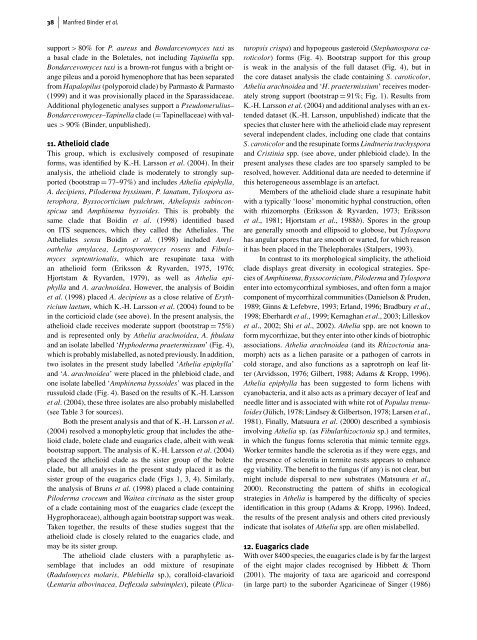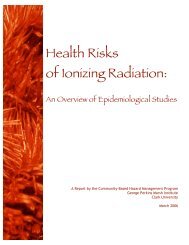The phylogenetic distribution of resupinate forms ... - Clark University
The phylogenetic distribution of resupinate forms ... - Clark University
The phylogenetic distribution of resupinate forms ... - Clark University
Create successful ePaper yourself
Turn your PDF publications into a flip-book with our unique Google optimized e-Paper software.
38 Manfred Binder et al.<br />
support > 80% for P. aureus and Bondarcevomyces taxi as<br />
a basal clade in the Boletales, not including Tapinella spp.<br />
Bondarcevomyces taxi is a brown-rot fungus with a bright orange<br />
pileus and a poroid hymenophore that has been separated<br />
from Hapalopilus (polyporoid clade) by Parmasto & Parmasto<br />
(1999) and it was provisionally placed in the Sparassidaceae.<br />
Additional <strong>phylogenetic</strong> analyses support a Pseudomerulius–<br />
Bondarcevomyces–Tapinella clade (= Tapinellaceae) with values<br />
> 90% (Binder, unpublished).<br />
11. Athelioid clade<br />
This group, which is exclusively composed <strong>of</strong> <strong>resupinate</strong><br />
<strong>forms</strong>, was identified by K.-H. Larsson et al. (2004). In their<br />
analysis, the athelioid clade is moderately to strongly supported<br />
(bootstrap = 77–97%) and includes Athelia epiphylla,<br />
A. decipiens, Piloderma byssinum, P. lanatum, Tylospora asterophora,<br />
Byssocorticium pulchrum, Athelopsis subinconspicua<br />
and Amphinema byssoides. This is probably the<br />
same clade that Boidin et al. (1998) identified based<br />
on ITS sequences, which they called the Atheliales. <strong>The</strong><br />
Atheliales sensu Boidin et al. (1998) included Amyloathelia<br />
amylacea, Leptosporomyces roseus and Fibulomyces<br />
septentrionalis, which are <strong>resupinate</strong> taxa with<br />
an athelioid form (Eriksson & Ryvarden, 1975, 1976;<br />
Hjortstam & Ryvarden, 1979), as well as Athelia epiphylla<br />
and A. arachnoidea. However, the analysis <strong>of</strong> Boidin<br />
et al. (1998) placed A. decipiens as a close relative <strong>of</strong> Erythricium<br />
laetum, which K.-H. Larsson et al. (2004) found to be<br />
in the corticioid clade (see above). In the present analysis, the<br />
athelioid clade receives moderate support (bootstrap = 75%)<br />
and is represented only by Athelia arachnoidea, A. fibulata<br />
and an isolate labelled ‘Hyphoderma praetermissum’ (Fig. 4),<br />
which is probably mislabelled, as noted previously. In addition,<br />
two isolates in the present study labelled ‘Athelia epiphylla’<br />
and ‘A. arachnoidea’ were placed in the phlebioid clade, and<br />
one isolate labelled ‘Amphinema byssoides’ was placed in the<br />
russuloid clade (Fig. 4). Based on the results <strong>of</strong> K.-H. Larsson<br />
et al. (2004), these three isolates are also probably mislabelled<br />
(see Table 3 for sources).<br />
Both the present analysis and that <strong>of</strong> K.-H. Larsson et al.<br />
(2004) resolved a monophyletic group that includes the athelioid<br />
clade, bolete clade and euagarics clade, albeit with weak<br />
bootstrap support. <strong>The</strong> analysis <strong>of</strong> K.-H. Larsson et al. (2004)<br />
placed the athelioid clade as the sister group <strong>of</strong> the bolete<br />
clade, but all analyses in the present study placed it as the<br />
sister group <strong>of</strong> the euagarics clade (Figs 1, 3, 4). Similarly,<br />
the analysis <strong>of</strong> Bruns et al. (1998) placed a clade containing<br />
Piloderma croceum and Waitea circinata as the sister group<br />
<strong>of</strong> a clade containing most <strong>of</strong> the euagarics clade (except the<br />
Hygrophoraceae), although again bootstrap support was weak.<br />
Taken together, the results <strong>of</strong> these studies suggest that the<br />
athelioid clade is closely related to the euagarics clade, and<br />
may be its sister group.<br />
<strong>The</strong> athelioid clade clusters with a paraphyletic assemblage<br />
that includes an odd mixture <strong>of</strong> <strong>resupinate</strong><br />
(Radulomyces molaris, Phlebiella sp.), coralloid-clavarioid<br />
(Lentaria albovinacea, Deflexula subsimplex), pileate (Plica-<br />
turopsis crispa) and hypogeous gasteroid (Stephanospora caroticolor)<br />
<strong>forms</strong> (Fig. 4). Bootstrap support for this group<br />
is weak in the analysis <strong>of</strong> the full dataset (Fig. 4), but in<br />
the core dataset analysis the clade containing S. caroticolor,<br />
Athelia arachnoidea and ‘H. praetermissium’ receives moderately<br />
strong support (bootstrap = 91%; Fig. 1). Results from<br />
K.-H. Larsson et al. (2004) and additional analyses with an extended<br />
dataset (K.-H. Larsson, unpublished) indicate that the<br />
species that cluster here with the athelioid clade may represent<br />
several independent clades, including one clade that contains<br />
S. caroticolor and the <strong>resupinate</strong> <strong>forms</strong> Lindtneria trachyspora<br />
and Cristinia spp. (see above, under phlebioid clade). In the<br />
present analyses these clades are too sparsely sampled to be<br />
resolved, however. Additional data are needed to determine if<br />
this heterogeneous assemblage is an artefact.<br />
Members <strong>of</strong> the athelioid clade share a <strong>resupinate</strong> habit<br />
with a typically ‘loose’ monomitic hyphal construction, <strong>of</strong>ten<br />
with rhizomorphs (Eriksson & Ryvarden, 1973; Eriksson<br />
et al., 1981; Hjortstam et al., 1988b). Spores in the group<br />
are generally smooth and ellipsoid to globose, but Tylospora<br />
has angular spores that are smooth or warted, for which reason<br />
it has been placed in the <strong>The</strong>lephorales (Stalpers, 1993).<br />
In contrast to its morphological simplicity, the athelioid<br />
clade displays great diversity in ecological strategies. Species<br />
<strong>of</strong> Amphinema, Byssocorticium, Piloderma and Tylospora<br />
enter into ectomycorrhizal symbioses, and <strong>of</strong>ten form a major<br />
component <strong>of</strong> mycorrhizal communities (Danielson & Pruden,<br />
1989; Ginns & Lefebvre, 1993; Erland, 1996; Bradbury et al.,<br />
1998; Eberhardt et al., 1999; Kernaghan et al., 2003; Lilleskov<br />
et al., 2002; Shi et al., 2002). Athelia spp. are not known to<br />
form mycorrhizae, but they enter into other kinds <strong>of</strong> biotrophic<br />
associations. Athelia arachnoidea (and its Rhizoctonia anamorph)<br />
acts as a lichen parasite or a pathogen <strong>of</strong> carrots in<br />
cold storage, and also functions as a saprotroph on leaf litter<br />
(Arvidsson, 1976; Gilbert, 1988; Adams & Kropp, 1996).<br />
Athelia epiphylla has been suggested to form lichens with<br />
cyanobacteria, and it also acts as a primary decayer <strong>of</strong> leaf and<br />
needle litter and is associated with white rot <strong>of</strong> Populus tremuloides<br />
(Jülich, 1978; Lindsey & Gilbertson, 1978; Larsen et al.,<br />
1981). Finally, Matsuura et al. (2000) described a symbiosis<br />
involving Athelia sp. (as Fibularhizoctonia sp.) and termites,<br />
in which the fungus <strong>forms</strong> sclerotia that mimic termite eggs.<br />
Worker termites handle the sclerotia as if they were eggs, and<br />
the presence <strong>of</strong> sclerotia in termite nests appears to enhance<br />
egg viability. <strong>The</strong> benefit to the fungus (if any) is not clear, but<br />
might include dispersal to new substrates (Matsuura et al.,<br />
2000). Reconstructing the pattern <strong>of</strong> shifts in ecological<br />
strategies in Athelia is hampered by the difficulty <strong>of</strong> species<br />
identification in this group (Adams & Kropp, 1996). Indeed,<br />
the results <strong>of</strong> the present analysis and others cited previously<br />
indicate that isolates <strong>of</strong> Athelia spp. are <strong>of</strong>ten mislabelled.<br />
12. Euagarics clade<br />
With over 8400 species, the euagarics clade is by far the largest<br />
<strong>of</strong> the eight major clades recognised by Hibbett & Thorn<br />
(2001). <strong>The</strong> majority <strong>of</strong> taxa are agaricoid and correspond<br />
(in large part) to the suborder Agaricineae <strong>of</strong> Singer (1986)
















